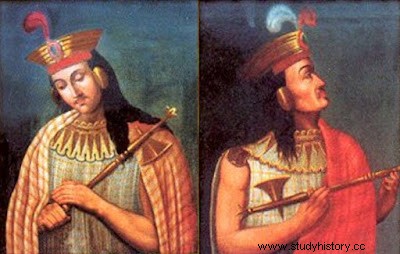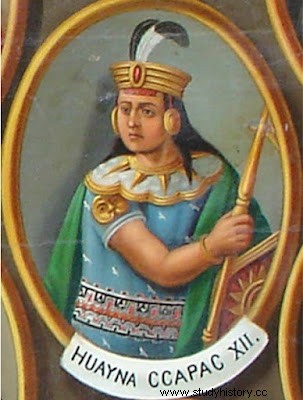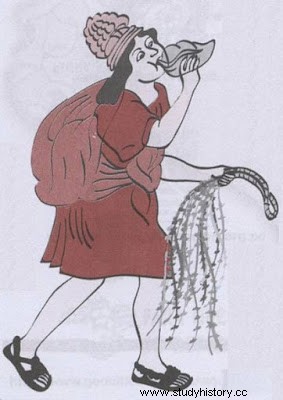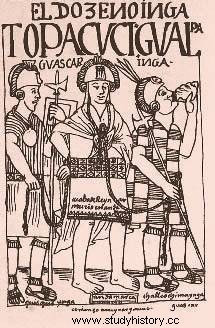 Portraits of Huáscar and Atahualpa that appeared on Peruvian stamps issued in 2004. The death of a Sapa Inca The war between the two brothers began with the death of the Sapa Inca Huayna Cápac and his heir, Ninan Cuyuhi, in 1527. Both probably died of smallpox, a disease that spread rapidly among the indigenous communities since the arrival of the Indians. Spaniards to the continent. Traditionally, the Sapa Inca bequeathed the throne to his eldest son. In the case of Huayna Cápac, however, his eldest son, Ninan Cuyochi, had predeceased him. Shortly after his son's death, Huayna Cápac also found himself on his own deathbed, and it was for this reason that the Sapa Inca broke tradition and divided the empire between his two younger sons:Huáscar and Atahualpa.
Portraits of Huáscar and Atahualpa that appeared on Peruvian stamps issued in 2004. The death of a Sapa Inca The war between the two brothers began with the death of the Sapa Inca Huayna Cápac and his heir, Ninan Cuyuhi, in 1527. Both probably died of smallpox, a disease that spread rapidly among the indigenous communities since the arrival of the Indians. Spaniards to the continent. Traditionally, the Sapa Inca bequeathed the throne to his eldest son. In the case of Huayna Cápac, however, his eldest son, Ninan Cuyochi, had predeceased him. Shortly after his son's death, Huayna Cápac also found himself on his own deathbed, and it was for this reason that the Sapa Inca broke tradition and divided the empire between his two younger sons:Huáscar and Atahualpa.The division of the Inca empire Of the two sons, Huáscar was the eldest, and the second son of Huayna Cápac's legitimate wife. Meanwhile, Atahualpa was said to be the fruit of his union with one of his concubines. Therefore, he handed over the empire to Huáscar except for Quito and its surroundings, to the north of the territory, which went to Atahualpa. Ruling Cuzco, the capital of the Inca empire, Huáscar won the loyalty of most of the people. Atahualpa, on the other hand, achieved the loyalty of the Inca army, located to the north to subdue the border tribes. In addition, three important generals, Chalcuchímac, Quisquis and Rumiñahui, swore allegiance to the youngest of the brothers.
 The 12th Inca, Huayna Cápac The beginning of the war It is possible that Huayna Cápac thought that both brothers would govern the empire together, in harmony. But it was not like that. Huáscar saw Atahualpa's command over the Inca army as a direct threat to his position as Sapa Inca, and decided to attack first to try to conquer Quito. At first this maneuver seemed successful, defeating Huáscar's troops to Atahualpa and capturing him near Tomebamba. However, Atahualpa managed to escape and returned to Quito to regroup his troops. Although Huáscar tried to conquer the northern capital, he was defeated and forced to retreat south again. It was then that Atahualpa sent an army led by Chalcuchímac and Quisquis against Huáscar, while General Rumiñahui remained in Quito to protect the plaza.
The 12th Inca, Huayna Cápac The beginning of the war It is possible that Huayna Cápac thought that both brothers would govern the empire together, in harmony. But it was not like that. Huáscar saw Atahualpa's command over the Inca army as a direct threat to his position as Sapa Inca, and decided to attack first to try to conquer Quito. At first this maneuver seemed successful, defeating Huáscar's troops to Atahualpa and capturing him near Tomebamba. However, Atahualpa managed to escape and returned to Quito to regroup his troops. Although Huáscar tried to conquer the northern capital, he was defeated and forced to retreat south again. It was then that Atahualpa sent an army led by Chalcuchímac and Quisquis against Huáscar, while General Rumiñahui remained in Quito to protect the plaza.Slanderous stories about Huáscar It has been said that Huáscar gradually became a ruler who was little loved by his people because, for example, he was accused of having murdered the lords who had accompanied the corpse of his father, Huayna Cápac. These gentlemen occupied a high social position in Cuzco. As if this were not enough, the nobility turned their back on him when Huáscar allegedly threatened to take the belongings of the royal mummies and then burn their sacred bodies. It was even claimed that Huáscar had all the messengers sent by Atahualpa killed. He was also accused of having cut off the noses of some messengers - who were carrying gifts from Atahualpa - and sending them back with their clothing torn. It is very likely that these accusations about the cruelty of Huáscar came from the winning side, that is, from Atahualpa himself and his generals and allies, while the version of history lived by Huáscar and his people would have been lost forever. .
 Chasqui blowing a pututu (conch shell). The chasquis were the fast messengers of the Inca Empire, and it was said that they could run up to 240 kilometers in a day. Through an efficient relay system, they were able to get an important message from Quito to Cuzco in just one week. The end of the war between the two brothers and the creation of a new empire In 1532, Atahualpa's army defeated Huáscar's forces in a decisive battle outside Cuzco, capturing him and taking him prisoner. The news of this victory reached Atahualpa when he was in the city of Cajamarca because, just at that time, strange white-skinned men with "wool on their faces" had been seen in that area... The Spanish had arrived. Atahualpa could not then guess how short his reign would be, since those strange men would end up defeating his armies and executing him, putting an end to his Empire. In fact, Atahualpa was imprisoned very shortly after his victory over Huáscar. The war between the two brothers did not serve to achieve the reunification of the Inca empire under a single sovereign, but rather indirectly caused the conquest of the Incas by the Incas. Spanish newcomers.
Chasqui blowing a pututu (conch shell). The chasquis were the fast messengers of the Inca Empire, and it was said that they could run up to 240 kilometers in a day. Through an efficient relay system, they were able to get an important message from Quito to Cuzco in just one week. The end of the war between the two brothers and the creation of a new empire In 1532, Atahualpa's army defeated Huáscar's forces in a decisive battle outside Cuzco, capturing him and taking him prisoner. The news of this victory reached Atahualpa when he was in the city of Cajamarca because, just at that time, strange white-skinned men with "wool on their faces" had been seen in that area... The Spanish had arrived. Atahualpa could not then guess how short his reign would be, since those strange men would end up defeating his armies and executing him, putting an end to his Empire. In fact, Atahualpa was imprisoned very shortly after his victory over Huáscar. The war between the two brothers did not serve to achieve the reunification of the Inca empire under a single sovereign, but rather indirectly caused the conquest of the Incas by the Incas. Spanish newcomers. Huáscar captive from Atahualpa's army, drawing by Felipe Huamán Poma de Ayala
Huáscar captive from Atahualpa's army, drawing by Felipe Huamán Poma de Ayala Fonts:
Hidden Inca Tours, 2015. The Inca Civil War:Not Civil at All. [Online]Available at:https://hiddenincatours.com/the-inca-civil-war-not-civil-at-all/
Minster, C., 2015. Biography of Atahualpa, Last King of the Inca . [Online] Available at:http://latinamericanhistory.about.com/od/theconquestofperu/p/08Atahualpa.htm
Minster, C., 2015. Huáscar and Atahualpa:An Inca Civil War. [Online]Available at:http://latinamericanhistory.about.com/od/theconquestofperu/a/08incacivilwar.htm
Rodriguez, J., 2014. 10 Broken Lines Of Succession That Changed The World. [Online]Available at:http://listverse.com/2014/07/20/10-broken-lines-of-succession-that-changed-the-world/
Spanish Wars, 2012. The Conquest of the Inca Empire. [Online]Available at:http://www.spanishwars.net/16th-century-conquest-inca-empire.html
www.historyworld.net, 2015. History of the Incas. [Online]Available at:http://www.historyworld.net/wrldhis/PlainTextHistories.asp?groupid=3077
www.sjusd.org, 2015. Civil War. [Online]Available at:http://www.sjusd.org/leland/teachers/sgillis/geog/la/inca_civil_war.pdf
